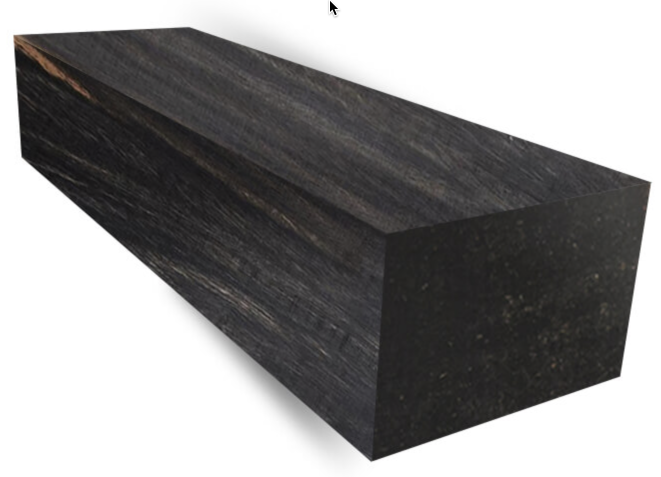We all know what ebony looks like and admire quality woodwork that uses it. Think of Brian Newell's Best in Show DIW entry from 2011. But how much do you know about the tree which is the source of ebony? I gathered information about these wonderful trees after reading about the purchase in 2011 by the Taylor Guitar company of an actual ebony mill in Cameroon. Del Cover hopes to have Bob Taylor present a program at a future SDFWA general meeting.
Trees that produce true Ebony belong to the Genus Diospyros which includes the Persimmon tree and 700+ other species of shrubs and trees. Diospyros species grow in the tropics, the majority in west Africa, specifically in the nations of Cameroon, Nigeria, Gabon, Congo, Central African Republic, and Democratic Republic of Congo. They also occur in southeast Asia, Indonesia and the islands of Madagascar and Mauritius; typically singly or in small clusters, usually deep in tropical rain forests.
Trees reach a maximum height of 50-60′, diam. 2-3′. Life cycle is 80 years. Sapwood is creamy white and may account for 50-70% of a log's volume. Mean diam. growth is only a few millimeters/year. Two trees in central Gabon, measured over a ten year period, had average annual growth rate of only 1 mm. Heartwood weighs 60#/ft3, grain is diffuse-porous, visible only with magnification. Ebony's density and hardness rating (3,800 on the Janka scale) are responsible for its ability to take a remarkable polish.
The following species produce true ebony with qualities suitable for woodworking:
D crassiflora – (Gabon ebony) – west Africa
D. celebico – (Macassar ebony) – Indonesia
D. ebenum – (Ceylon ebony) – India, Sri Lanka
D. tesselaria – Mauritius & Mascarene islands
D. mun – Viet Nam & Laos – virtually extinct
Three other species produce black or very dark brown wood; Katalox (swartzia cubensis, Mexican royal ebony, extremely hard), African Blackwood (dalbergia melanoxylon, also very hard) and Wenge (millettia laurentia, softer with very coarse grain); none are perfect substitutes.
There is an extensive literature on the process of “ebonizing” wood of other species; this just means treating woods with a high tannin content with iron acetate or applying various stains and paint. But nothing quite matches the luster and feel of true ebony which has been appreciated since antiquity.
Gabon ebony is the most highly prized species. Macassar ebony always has streaks or marbling of light colored wood. All of the diospyros species are either vulnerable to extinction or critically endangered. Export of ebony from Madagascar and Sri Lanka is illegal. But illegal logging still flourishes in most countries due to corruption and civil turmoil. Nearly all large trees except a few in remote areas have long since been felled. Logging is done manually. Trees are stripped of sapwood, cut to lengths short enough to be hand carried, and hauled out of the forest.
If not sealed, logs are subject to checking. Until recently logs which were not uniformly black were simply discarded because their value was not worth the labor to haul them out. Current retail prices for ebony at two U.S. online sources (in 2015) of are;
$35 – Gabon ebony – 1 1/2 x 1 1/2 x 18″
$28 – Macassar ebony – 2 x 2 x 12″
$307.99 – Gabon ebony – 3 3/8 x 2 1/8 x 35 1/8″
Trees of the diospyros species are dioecious. That is, male and female trees must be planted in order to harvest fruit (which is edible) or seeds. Trees can be grown from seed but seeds have short viability, must be planted fresh and kept moist during germination and early growth. If you are interested in creating a plantation you may have to travel to Africa to gather seeds and put the trees in your will for your grandchildren.
By Dick Ugoretz (originally published on April 2015)
Editor's Note: Light edits have been made to remove broken web links.

